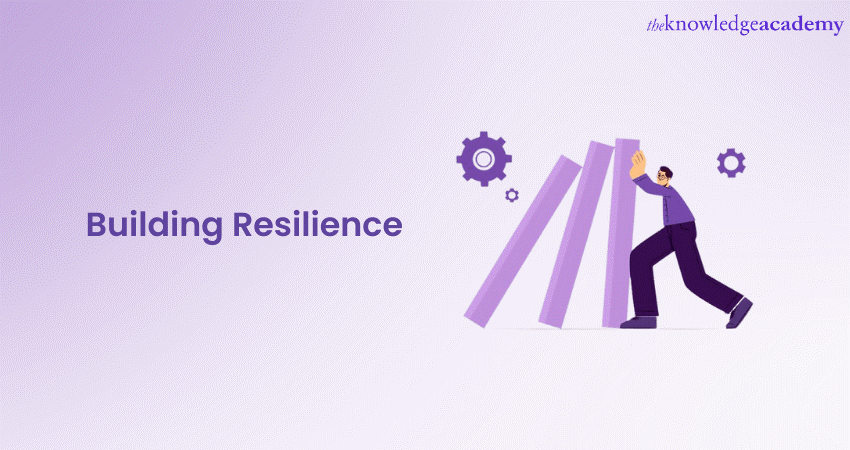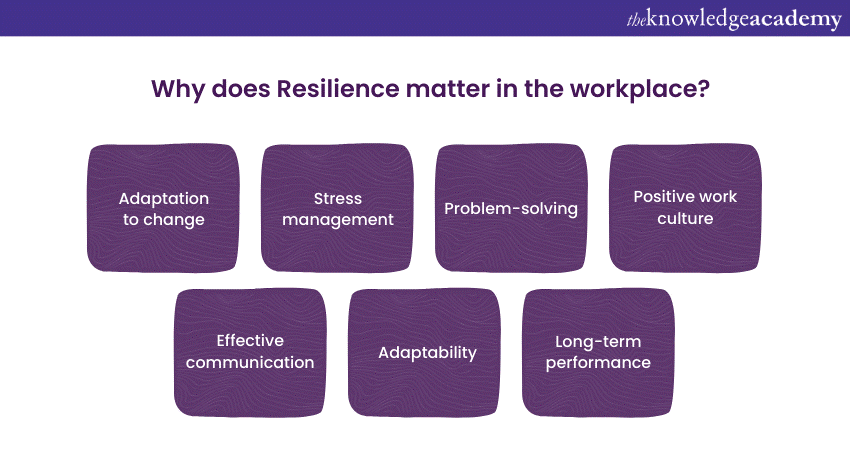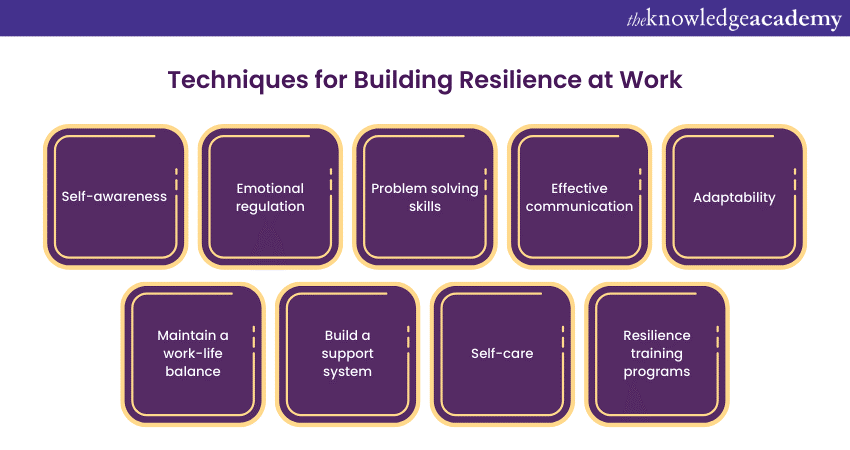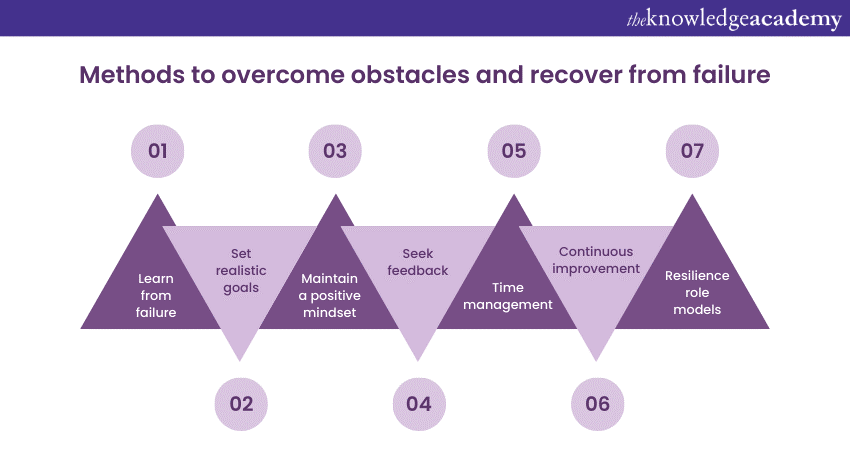We may not have the course you’re looking for. If you enquire or give us a call on 01344203999 and speak to our training experts, we may still be able to help with your training requirements.
We ensure quality, budget-alignment, and timely delivery by our expert instructors.

In today's fast-paced and ever-changing work environments, the ability to adapt to new challenges and remain productive is essential. Building Resilience, both personally and professionally, is the key to overcoming obstacles and recovering from failures in the workplace.
Resilience is not a trait but a skill that can be developed and strengthened over time. In this blog, we'll explore what Resilience is. Learn about Building Resilience, a blend of techniques and methods to overcome obstacles and recover from failures.
Table of Contents
1) What is Resilience?
2) Why does Resilience matter in the workplace?
3) Techniques for Building Resilience at Work
4) Methods to overcome obstacles and recover from failure
5) Conclusion
What is Resilience?
Resilience is the individual's capacity to withstand and recover from adversity, setbacks, or difficult situations. It's the ability to adapt, bounce back, and maintain one's mental and emotional well-being when faced with challenges. Resilience is not a fixed trait but a skill that can be developed and strengthened over time.
In the face of stress, change, or failure, resilient individuals exhibit the ability to manage their emotions, maintain a positive outlook, and effectively solve problems. They can navigate uncertainty and overcome obstacles with determination and flexibility.
Developing Resilience involves self-awareness, emotional regulation, problem-solving skills, and building a strong support system, often assessed through Resilience Interview Questions. By nurturing these qualities and practices, individuals can enhance their Resilience, which, in turn, empowers them to face life's challenges with greater confidence and a more positive outlook.

Why does Resilience matter in the workplace?

Building Resilience in the workplace is not only a personal development endeavour but also a strategic advantage for organisations striving to thrive in a dynamic and challenging business landscape. Resilience is of paramount importance in the workplace for several compelling reasons:
1) Adaptation to change: Work environments are constantly evolving due to technological advancements, industry trends, and economic shifts. Resilient employees can readily adapt to these changes, ensuring that they remain effective and productive despite the upheaval.
2) Stress management: Work-related stress is a prevalent issue that can lead to burnout and negative physical and mental health effects. Resilient individuals are usually better equipped to manage stress maintaining their well-being even in high-pressure situations.
3) Problem-solving: Resilience empowers employees to tackle problems and setbacks with a positive and solution-oriented mindset. They are more likely to find innovative solutions and persevere in the face of adversity, fostering a culture of creativity and problem-solving in the workplace.
4) Positive work culture: Resilience is contagious. When employees develop this skill, they contribute to a more positive work culture. Colleagues are more likely to support one another during challenging times, which fosters teamwork and camaraderie.
5) Effective communication: Resilient individuals tend to be better communicators. They can express their concerns, seek help when needed, and actively listen to others. This enhances collaboration and cooperation in the workplace.
6) Adaptability: Resilience is closely linked to adaptability. Those who are resilient embrace change as an opportunity for growth rather than a threat. They are more likely to navigate transitions with grace and positivity.
7) Long-term performance: Resilient employees are more likely to remain committed and engaged in their roles. They are less prone to burnout, absenteeism, and turnover, which can have a positive impact on an organisation's long-term performance and success.
Unlock your peak productivity with Attention Management Training - sharpen your focus, supercharge your success!
Techniques for Building Resilience at Work

Building Resilience at work involves the development and application of various techniques that enhance your ability to withstand and recover from challenges and setbacks. Here are some key techniques for Building Resilience in the workplace:
1) Self-awareness:
Self-awareness is the cornerstone of Resilience. It involves understanding your thoughts, emotions, and reactions, which are critical in managing stress and adversity. To enhance self-awareness:
a) Practice mindfulness: Regular mindfulness meditation can help you become more in tune with your emotions and thoughts, making it easier to identify triggers and stressors.
b) Keep a journal: Document your thoughts and feelings, especially during challenging situations. Reflect on your reactions to gain insight into your emotional responses.
2) Emotional regulation:
Effective emotional regulation is essential for Resilience. It's the ability to manage your emotions, especially in high-stress situations. Techniques to regulate your emotions include:
a) Deep breathing exercises: Take deep, slow breaths to calm your nervous system and reduce the intensity of emotional reactions.
b) Progressive muscle relaxation: This technique involves tensing and then relaxing different muscle groups to release physical tension, which can help manage emotional stress.
c) Cognitive reframing: Challenge and reframe negative thoughts to adopt a more positive perspective on difficult situations.
3) Problem-solving skills:
Resilience relies on your ability to solve problems effectively. When facing a challenge, consider these problem-solving techniques:
a) Break challenges into smaller steps: Dividing a complex problem into manageable tasks makes it less daunting and helps you maintain a sense of progress.
b) Collaborative problem-solving: Engage your colleagues to brainstorm creative solutions, benefiting from their diverse perspectives and experiences.
4) Effective communication:
Open and honest communication is vital for Resilience. It enables you to express concerns, seek support, and collaborate with others. Effective communication techniques include:
a) Active Listening: Pay close attention to what others are saying, seek to understand their perspectives, and provide thoughtful responses.
b) Constructive feedback: When giving feedback, do so in a constructive and non-judgmental manner to encourage learning and growth.
c) Conflict resolution: Develop skills to resolve conflicts through respectful and solution-oriented discussions.
5) Adaptability:
Resilience and adaptability go hand in hand. To enhance your adaptability:
a) Embrace change: Consider embracing change for growth in both personal and professional life.
b) Lifelong learning: Cultivate a thirst for knowledge and skill development, as this promotes adaptability by keeping you up-to-date with industry changes and innovations.
6) Maintain a work-life balance:
Resilience extends beyond the workplace. It's essential to maintain a good and healthy work-life balance to prevent burnout. Techniques for achieving this balance include:
a) Set boundaries: Clearly define your work hours and avoid taking work-related calls or emails outside those hours.
b) Schedule breaks: Regularly take short breaks during the workday to recharge and prevent burnout.
c) Prioritise self-care: Allocate time for hobbies, exercise, and relaxation to rejuvenate and maintain overall well-being.
7) Build a support system:
Nurturing a strong support system in the workplace is crucial. Techniques to build a support system include:
a) Networking: Connect with colleagues, mentors, and peers who can provide guidance, encouragement, and assistance during challenging times.
b) Mentoring relationships: Seek out mentors who can offer valuable advice and support in your professional development.
c) External relationships: Develop friendships and relationships outside of work to gain a different perspective and emotional support.
8) Self-care:
Prioritising self-care practices is fundamental to Resilience. This includes:
a) Regular exercise: Engage in physical activity to reduce stress and boost your overall well-being.
b) Healthy eating: Nourish your body with nutritious food to maintain physical and mental health.
c) Adequate sleep: Ensure you get enough sleep to recharge your body and mind.
9) Resilience training programs:
Many organisations offer Resilience training programs to help employees develop this critical skill. These programs often include workshops and resources to enhance Resilience, stress management, and overall well-being.
Unlock your organisation's future success with strategic planning and thinking. Join our Strategic Planning And Thinking Training now.
Methods to overcome obstacles and recover from failure

Overcoming obstacles and recovering from failure are vital aspects of Building Resilience at work. These methods can help you navigate setbacks, learn from your experiences, and emerge stronger and more capable. Here's a detailed exploration of the methods to overcome obstacles and recover from failure in the workplace:
Learn from failure
Here are the steps to follow this method:
a) Analyse the failure: When faced with a failure, take the time to understand what went wrong. Identify the contributing factors, mistakes, and areas where you could have improved.
b) Accept responsibility: Acknowledge your role in the failure and avoid the blame game. Taking responsibility is the first step towards learning from the experience.
c) Extract lessons: Failure is a valuable teacher. Identify the lessons you can draw from the experience. What could you have done differently? What skills or knowledge could you acquire to prevent a similar failure in the future?
d) Adjust your approach: Armed with insights from your failure, adapt your approach for future endeavours. Make concrete changes and improvements based on the lessons you've learned.
Set realistic goals
Here are the steps to follow this method:
a) SMART goals: When setting goals, use the Specific, Measurable, Achievable, Relevant, Time-bound (SMART) criteria. Realistic and achievable goals prevent you from setting yourself up for potential failure and unnecessary stress.
b) Break down goals: Divide larger goals into smaller, manageable steps. This method allows you to track progress more effectively and maintain a sense of accomplishment.
Maintain a positive mindset
Here are the steps to follow this method:
a) Focus on strengths: Concentrate on your strengths and past successes, no matter how small they may seem. Positive self-affirmation can bolster your self-confidence.
b) Cultivate optimism: Try to maintain an optimistic outlook, even in the face of adversity. Optimism can be a powerful motivator.
c) Resilience as a mindset: Frame Resilience as a mindset. Embrace setbacks as opportunities for growth and remember that challenges are part of the journey toward success.
Seek feedback
Here are the steps to follow this method:
a) Constructive feedback: Welcome constructive feedback from colleagues, supervisors, or mentors. Honest feedback can provide valuable insights into areas for improvement.
b) Use feedback wisely: Act upon feedback by making necessary adjustments and applying the lessons to your work. This iterative process contributes to continuous improvement.
Time management
Here are the steps to follow this method:
a) Prioritisation: Use effective time management techniques to prioritise tasks based on their importance and deadlines.
b) Allocate breaks: Schedule regular breaks to avoid burnout and maintain focus and productivity. Time management techniques, like the Pomodoro Technique, can help with this.
Continuous learning
Here are the steps to follow this method:
a) Stay curious: Cultivating a natural curiosity and love for learning can help you continually adapt and acquire new skills.
b) Professional development: Invest in professional development opportunities, such as courses, workshops, and certifications, to stay relevant in your field.
Resilience role models
Here are the steps to follow this method:
a) Identify role models: Find individuals in your workplace or industry who demonstrate strong Resilience. Learn from their experiences, strategies, and approaches to overcoming obstacles and setbacks.
b) Mentoring: Consider seeking mentorship or guidance from these role models. They can provide personalised insights and advice based on their experiences.
Unlock your full potential with our Personal Development Training and become the best version of yourself today.
Conclusion
Building Resilience in the workplace is vital for adapting to change, managing stress, and thriving in challenging environments. By employing techniques such as self-awareness, problem-solving, and effective communication, and by mastering the art of learning from failure and setting realistic goals, individuals can strengthen their Resilience. These methods not only enhance personal well-being but also contribute to a positive work culture, promoting productivity and success for both employees and organisations.
Unlock peace of mind and boost productivity with our Stress Management Training – join us today to regain control over your life!
Frequently Asked Questions
What are the Other Resources and Offers Provided by The Knowledge Academy?

The Knowledge Academy takes global learning to new heights, offering over 3,000 online courses across 490+ locations in 190+ countries. This expansive reach ensures accessibility and convenience for learners worldwide.
Alongside our diverse Online Course Catalogue, encompassing 19 major categories, we go the extra mile by providing a plethora of free educational Online Resources like News updates, Blogs, videos, webinars, and interview questions. Tailoring learning experiences further, professionals can maximise value with customisable Course Bundles of TKA.
Upcoming Career Growth Batches & Dates
Date
 Time Management Training
Time Management Training
Fri 9th May 2025
Fri 11th Jul 2025
Fri 12th Sep 2025
Fri 14th Nov 2025






 Top Rated Course
Top Rated Course


 If you wish to make any changes to your course, please
If you wish to make any changes to your course, please


